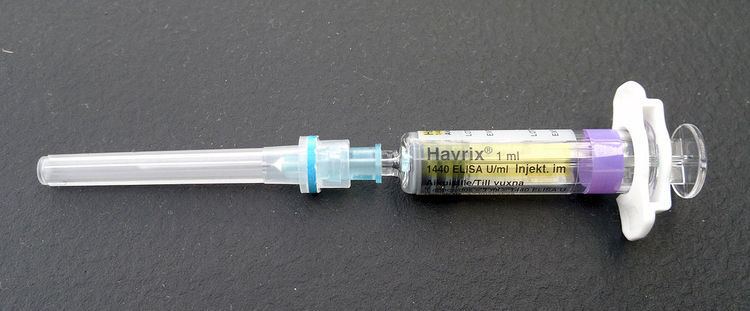MedlinePlus a695003 | Type Killed/Inactivated | |
 | ||
Trade names Biovac A, Havrix, others AHFS/Drugs.com Consumer Drug Information Pregnancycategory Safety undetermined, risk likely low | ||
Hepatitis A vaccine is a vaccine that prevents hepatitis A. It is effective in around 95% of cases and lasts for at least fifteen years and possibly a person's entire life. If given, two doses are recommended beginning after the age of one. It is given by injection into a muscle.
Contents
The World Health Organization (WHO) recommends universal vaccination in areas where the diseases is moderately common. Where the disease is very common, widespread vaccination is not recommended as all people typically develop immunity through infection when a child. The Center for Disease Control and Prevention (CDC) recommends vaccinating adults who are at high risk and all children.
Severe side effects are very rare. Pain at the site of injection occurs in about 15% of children and half of adults. Most hepatitis A vaccines contain inactivated virus while a few contain weakened virus. The ones with weakened virus are not recommended during pregnancy or in those with poor immune function. A few formulations combine hepatitis A with either hepatitis B or typhoid vaccine.
The first hepatitis A vaccine was approved in Europe in 1991 and the United States in 1995. It is on the World Health Organization's List of Essential Medicines, the most effective and safe medicines needed in a health system. In the United States it costs US$50–100.
Medical uses
Within the US, the vaccine was first phased in around 1996 for children living in high-risk areas. In 1999, it was spread to areas with elevating levels of infection. In the US today, the vaccine is strongly recommended for all children 12 to 23 months of age in an attempt to eradicate the virus nationwide. Although the original FDA license for Havrix by GlaxoSmithKline is dated in 1995, it has been in use in Europe since 1993.
According to the US Centers for Disease Control and Prevention, the following people should be vaccinated: all children over one year of age, people whose sexual activity puts them at risk, people with chronic liver disease, people who are being treated with clotting factor concentrates, people working within close proximity to the virus, and people who are living in communities where an outbreak is present. Hepatitis A is the most common vaccine-preventable virus acquired during travel, so people travelling to places where the virus is common like the Indian subcontinent, Africa, Central America, South America, the far East, and Eastern Europe should be vaccinated.
The vaccine should be given in the muscle of the upper arm and be given in two doses for the best protection. The initial dose of the vaccine should be followed up by a booster six to twelve months later. Protection against hepatitis A begins approximately two to four weeks after the initial vaccination. Protection last at least 15 years and is estimated to last at least 25 years if the full course is administered.
A Cochrane review found that both types of vaccines offer significant protection, for at least two years with the inactivated vaccine and at least five years with the attenuated vaccine. The review also found evidence to conclude that the inactivated vaccine was safe, but required more high quality evidence to assess the safety of the attenuated vaccine.
Commercial vaccines
This may not be a comprehensive list of all commercial hepatitis A vaccines available. Please note that the definition of "U" (units) may vary between manufacturers depending on what test they use to measure hepatitis A antigen in their products.
